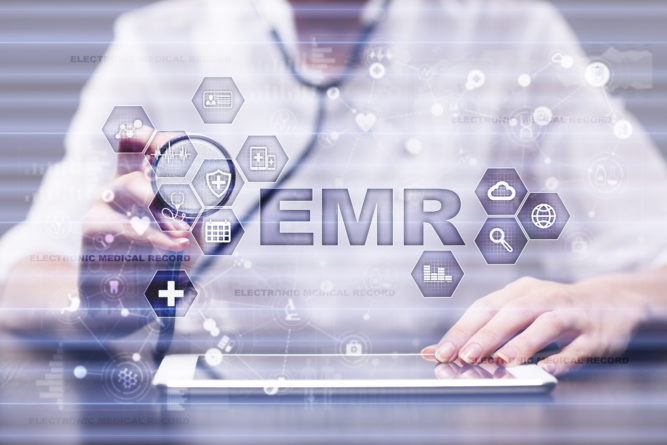
Last week, we started our blog series by introducing the Northern Physicians Organization (NPO), a large physician organization based in Traverse City, Michigan. One of NPO’s major goals is to improve care coordination, and EMR integration plays a significant role in working towards this goal. In this post, we will discuss EMR integration, its role in healthcare today, and how EMR integration helped NPO achieve better care coordination.
Transitioning From Paper-based to Electronic Medical Records
Medical records are an integral part of the healthcare system as they are the systematic documentation of every patients’ medical activity and history. Previously, these records were kept on paper which were filed in folders and stored in cabinets. A paper-based medical record system had many drawbacks and inefficiencies that created the opportunity for electronic medical records (EMRs).
Solving Issues with Paper-based Medical Records
The introduction of EMRs solved the major inefficiencies associated with paper-based medical records. Paper-based records required a lot of physical space, more time to create, update, and find, were not environmentally friendly, deteriorated over time, and were exposed to the risk of damage/loss. Electronic records address these issues as they are stored on a computer, requiring less physical space, and are easier to locate. These electronic records are also less likely to be damaged or lost as they can be backed up.
Benefits for Healthcare Providers
In addition to solving the issues that healthcare providers were facing with paper records, EMRs also provided additional benefits that make the jobs of healthcare professionals easier and promote efficiency. The use of technology allows physicians to see a patient’s entire medical history in one location and use other electronic tools to be better informed i.e., viewing trends over time and using schedulers for screenings/follow ups. Technology not only allows for savings in time and effort, but also allows access to better information, which results in better decision making . This causes the entire healthcare system to run more smoothly and efficiently.
Opportunity for Integration
EMRs also present an opportunity for further efficiency through integration. Now that medical information is primarily electronic, it can be shared and transferred, increasing the flow of communication amongst healthcare providers. This means that information duplication is less common, processes can be automated, and most importantly, data can be shared across facilities and regions.
Care Coordination and EMR Integration
Care coordination relies on the exchange of information in order to organize care activities amongst all those involved in a patient’s care. EMRs create the foundation for information exchange as all patient information is electronic. Integration allows the information stored in an EMR to be transferred, which is an integral part of achieving care coordination. The issue is that various EMRs are used by healthcare providers, and these systems are unable to communicate with each other. The source of this challenge is the different data standards used by various EMRs. In order for data exchange to occur, this data has to be changed through data transformation or translation services.
The goal of EMR integration is to facilitate data transformation in order to allow these systems to function as one cohesive whole. This results in communication and coordination between systems and, in turn, communication and coordination amongst healthcare professionals.
NPO Perspective
NPO consists of physicians, specialists, skilled nursing facilities and community health agencies across the largely rural population of Northern Michigan. In this region, there are many different electronic medical record formats which complicate communication and the exchange of information.
“In our region, there are a large number of disparate electronic medical records (EMRs), which complicates information exchange,” explains Marie Hooper, Executive Director at NPO. “It’s a challenge of process. Different practices, hospitals, and post-acute care facilities all have different workflows. We have to be able to accommodate for all of these processes.”
The 800 members in NPO, which include primary care physicians, specialty physicians, skilled nursing facilities, and mental health agencies, use a variety of EMRs including:
| eClinicalWorks® | NextGen® |
| Amazing Charts | Allscripts™ |
| Greenway Primesuite® | GE Centricity™ |
| Office Practicum™ | NETSMART™ |
| Triarq | MatrixCare® |
| iPatientCare™ | PointClickCare® |
In order to facilitate better care coordination and communication amongst facilities and members, certain information needed to be extracted from EMRs, primarily, patient demographic information in the form of ADT messages. Healthcare professionals need to access basic patient information as well as remain informed about when/where patients are admitted, discharged and transferred between facilities.
Iguana, with its ability to process any data format, was selected to facilitate the data transfer amongst these EMRs. In addition to the need for a system that could manage a multitude of EMRs and their corresponding difference in data formats, NPO also has a limited amount of internal IT resources. This is why they sought for both an interoperability partner and a product.
“Iguana came highly recommended by a vendor that I worked with at a previous position. Based on the breadth of integration required for their solution, I was confident in Iguana’s ability to handle multiple formats and to perform any required data transformations,” explains Ed Worthington, IT Director at NPO. “What I really liked however, was iNTERFACEWARE’s professional service offerings. With a small IT staff this really made the difference for me.”
Next week, we will go into specific details about the projects that Iguana was used to complete and how NPO further improved care coordination when we explore health information exchange (HIE) integration.
If you are looking to integrate, let us help. Contact us for more information.
